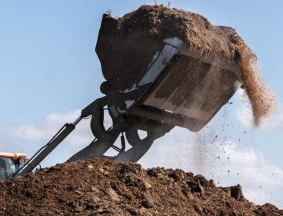Compost is a high-quality soil amendment that is rich in stable organic matter. Compost must be free of weed seeds, pathogens, and soil contaminants. In compost made from Dutch vegetable, fruit and garden waste, plastic can be a problem.
However, plastic contamination is difficult to demonstrate. An analysis of plastic particles in compost based on weight percent dry matter is not representative. Plastic weighs very little, so expressing plastic as a percentage by weight does not say enough about the contamination present. A new, innovative method makes it possible to analyse the area of plastic in cm2 per litre of compost. This new method uses a surface determination of the plastic present plus the total contaminants (excluding pebbles) in cm2 per litre of compost. This surface is calculated via a digital photo and software.
The new surface determination of contaminants in compost comprises two analyses:
- Determination of all contaminants (excl. pebbles) expressed in cm2 per litre. The contaminants are depicted by means of a photograph.
- Analysis of the surface area of only the plastic contaminants. The result of this is also expressed in cm2 per litre and shown by means of a photograph.

